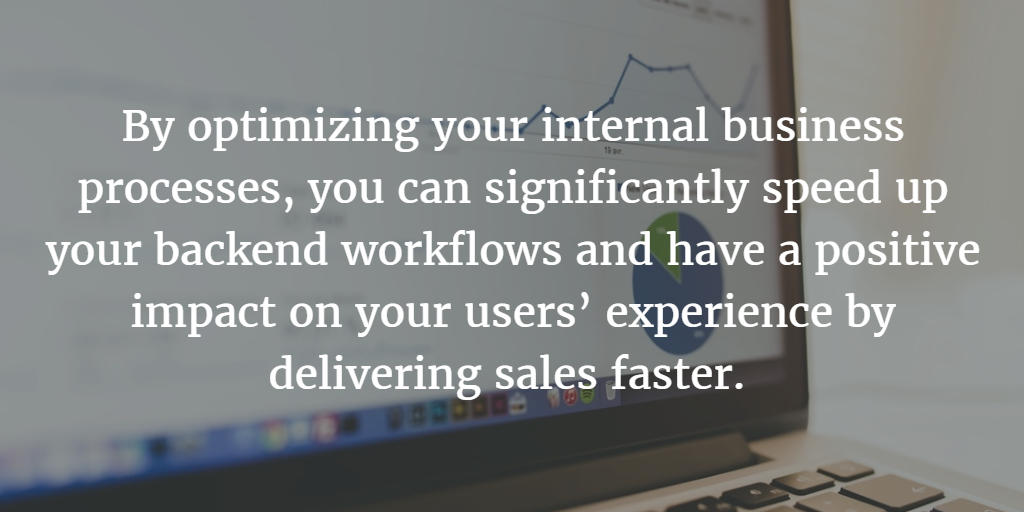How To Optimize Your Business Processes To Increase Online Sales
When it comes to increasing your website sales, your focus is most likely on building a visually appealing and responsive site that will attract visitors and make it easy for them to make a purchase.
However, there is so much you can do internally to increase your conversions; after all, how you manage your business will have a direct impact on what you are able to deliver to your customers. By optimizing your internal business processes, you can significantly speed up your backend workflows and have a positive impact on your users’ experience by delivering sales faster.
In this article, we go through the main two elements involved in this process.
1. Think about your content architecture
The most important element when designing your website is your content architecture, which refers to the way all your site content is organized and structured. The best content architectures are set up according to an organization’s unique goals and objectives. This is a truly important and yet often overlooked step of building a website, and will have an immense impact on your future internal processes and user journeys, giving you much more flexibility and efficiency.
When designing your content architecture, think about what your key objectives are (in this case, selling more), and map out your top five or ten user workflows. Once you do this, you can plan your entire content architecture around them, to make it as easy and efficient as possible for those particular workflows to be delivered.
Also try and make your content architecture as intuitive as possible and avoid hard-coding content as much as you can, so that any non-technical users, such as content editors, can easily update the site whenever needed.
The same applies to integrations. With time, you will undoubtedly need to update and add new integrations to your site, so ensure that your content architecture allows for the flexibility and scalability needed to accommodate this.
A well-planned content architecture will not only deliver a better user flow for your customers, but it will also make it as easy as possible for your content editors to build, edit and populate the site. This will increase efficiency both internally and externally, ensuring that products are delivered as quickly as possible.

2. Leverage data insights
Paying attention to your metrics will also give you insight into how your site is performing and, most importantly, how your sales are performing. Despite this, 87% of marketers consider data their organization’s most underutilized asset. If you are among this 87%, you are missing out one of your most valuable resources.
Sales data will offer you a good understanding of what improvements are needed to make it as easy as possible for your customers to make a purchase. Data analysis is an incredibly important step when optimizing your strategy, and is most effective when done consistently, whether that is daily, weekly or monthly.
On the design side, tools such as Google Analytics can give you key insights into the sorts of user flows customers are taking through your site; do these align with the user flows you would like them to take? Are users able to easily find content? Do any of your landing pages have higher-than-normal bounce rates and, if so, why? Are users leaving your site without converting, and if so, where?
You should also be able to generate and analyze data relating to all sales, so if your Ecommerce solution doesn’t provide this you could be missing out on key insights. What products are performing best? How are your special promotions performing? What’s your average order size? Could you provide any special offers based on this insight to encourage higher-revenue sales?
There are many metrics you could track according to your specific workflows and strategies, but some key ones are:
Conversion rate by landing page
Looking at your conversions by landing page will show you what pages are performing best; is there a particular product or promotion page that is highly effective? Has any page’s performance increased or decreased over time, and why? Could the success of high-performing pages be replicated on low-performing pages?
Per-session value
Knowing your average session value is a great way of establishing which of your products are most saleable based on their price. It is also a good metric to keep in mind when running promotions; you could set up a promotion at a value higher than the average sales value, encouraging visitors to spend a little more and increasing your overall sales revenue.
Bounce rate
Your bounce rate will give you insight into how individual pages or products on your website are performing. If a particular page has a very high bounce rate, there is most likely something you can do to improve it. Does the page title accurately describe its content or product? Or could the page design be unattractive? Is page content clearly organized and is information easy to find? Do you need to encourage users to remain on the site through additional call-to-actions (CTAs) or internal linking?
Top 10 pages (by Pageviews)
By looking at the ten pages with the highest pageviews, you can determine which of your site pages and products are most popular and see if these meet your expectations. Is there a particular page or product that should have more pageviews? Check to see if there is anything you can do to improve it, such as optimizing the design or changing the copy. On the other hand, if there is a particular product page with a high volume of pageviews but very few conversions, check to see if you can make the page more attractive or better describe the product.
Do you have any tips for improving Ecommerce business processes? Let us know in the comments!
If you would like to find out more about how Agility CMS can help you, request a free demo now.